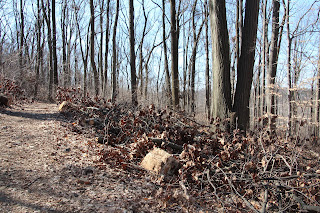Bloodroot (Sanguinaria canadensis) along the trail
Eight walkers joined me for the third installment of my One Trail Twelve Times monthly ramble along the Beech Springs Trail on a sunny Sunday March 18 afternoon. Though the unusually warm weather has advanced the appearance of some of the spring ephemerals, most of the blooming and bud-breaking seem to be about right on schedule.
Spicebush (Lindera benzoin)in flower
An owl pellet, full of hair but no tiny bones.
Indian hemp (Apocynum cannabinum) pod releasing winged seeds to the wind.
Non-native and aggressive but up-close attractive Gill-over-the Ground (Glechoma hederacea)
Also alien and extremely aggressive but attractive, Lesser Celandine (Ranunculus ficaria).
It's unusual to see a single blossom, since this plant blankets any area it invades.
Red-osier Dogwood (Cornus sericea) flowers
Red Maple (Acer rubrum) flowers
Group photo on the Eagle Scout bridge over the ravine
Beech Springs Trail through late winter woods
Skunk cabbage (Symplocarpus foetidus) in one of the springs
A red maple with a fungal canker, probably Neonectria galligena
The fields along the trail get mowed to control the invasion of shrubs.
The mower uncovered (and damaged) this deer scapula.
The Beech Springs Trail ends (or begins, depending on your perspective), in a long, majestic allee of white pines planted in the 1920s. In the deep pine straw long the allee, we discovered...
...the remnants of a puffball mushroom from last autumn, and...
...a bird's nest that had fallen from one of the pines.
I also discovered a hitchhiker on my pants leg at trail's end (a deer tick, Ixodes dammini).































